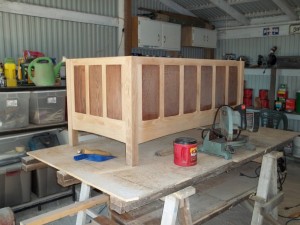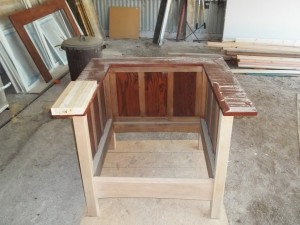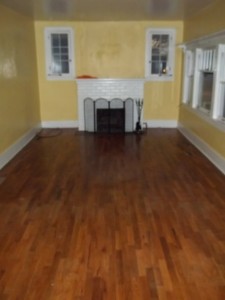Be sure to ask me sometime about my comfortable loveseat. It’s a two millennium project.
Trade Name: Red Oak
Genus: Quercus rubra
Janka Hardness (pounds-force): 1290
Description: The northern red oak can reach as much as 140’ in height with a better than three foot trunk diameter. Generally fast growing, and long lasting, sometimes living over 300 years. The wood is a pale red-brown, with sapwood coloration somewhat darker.
Location: Typically, northeastern United States and southeast Canada. Ranges from Nova Scotia to Georgia, along the Great Lakes region ranging through the Mississippi Valley, the lower Missouri Valley, and throughout the Ozarks. Farmed anywhere people want it, in climactic conditions consistent with the area noted above.
Common Aliases: Northern red oak, American red oak, Gray oak, Black Oak
No, that’s not a photoshop trick. Separate piece. I’ll spare everyone the agony of looking at the sofa, even closer to completion.
Performance: I’ve heard if you blow smoke through one end of a flat-sawn board, it will exit the other end. I’ve seen something similar happen when burning scrap of the stuff, so I’ll regard that as likely true. In any event, for this reason (moisture absorbing up the end grains), do not use red oak outside. You’ll eventually be disappointed. For interior applications, it is a fantastic, strong, and highly durable wood seen somewhere in most American homes. It will splinter if tools are not kept sharp. Affordable and versatile, Red Oak is an American woodworking favorite. It is by far the most widely available marketable hardwood in the United States. Many of these widely available products are closely related to the species reviewed here, and the specifications for other closely related products are widely available.
The likelihood I’ll be sanding this red oak floor in four weeks is almost exactly identical to the likelihood my brother’s offer on this house is accepted by the bank.
Common Uses: Indoor furnishings, cabinetry, tables, chairs, craftsman designs, flooring, moldings, millwork, veneer, and a variety of other uses.
From: The Wood Database
Common Name(s): Red Oak
Scientific Name: Quercus rubra
Distribution: Northeastern United States and Southeastern Canada
Tree Size: 80-115 ft (25-35 m) tall, 3-6 ft (1-2 m) trunk diameter
Average Dried Weight: 45 lbs/ft3 (725 kg/m3)
Basic Specific Gravity: .56
Hardness: 1,290 lbf (5,700 N)
Rupture Strength: 14,300 lbf/in2 (98,600 kPa)
Elastic Strength: 1,820,000 lbf/in2 (12,500 MPa)
Crushing Strength: 6,760 lbf/in2 (46.6 MPa)
Shrinkage: Radial: 4.0%, Tangential: 8.6%, Volumetric: 13.7%, T/R Ratio: 2.2


